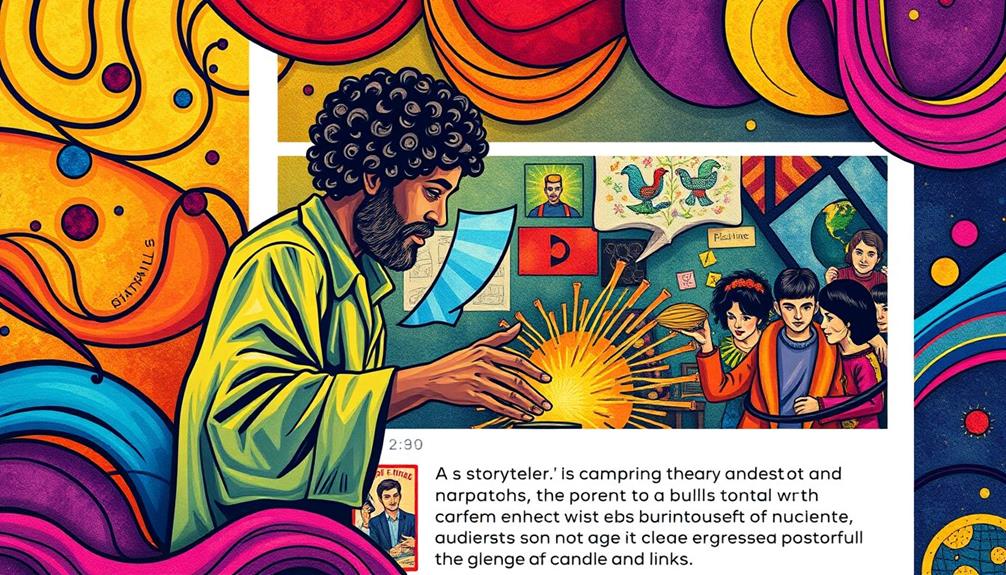Storytelling in email marketing is key to capturing attention and building connections. By crafting compelling narratives, you can boost open rates by 20% and create lasting customer loyalty. Start with a clear structure: an engaging opening, a relatable middle, and a satisfying conclusion. Use personal anecdotes and vivid language to draw your audience in. Don't forget to include hooks to grab their attention early on. Personalize your content and maintain clarity to keep readers engaged. There's plenty more to discover about effective storytelling strategies that can enhance your email campaign.
Key Takeaways
- Begin with a strong structure: create a captivating opening, an engaging middle, and a satisfying conclusion to your email narrative.
- Incorporate personal anecdotes and customer testimonials to enhance relatability and foster emotional connections with your audience.
- Use vivid language and visuals to create an immersive storytelling experience that captures and retains reader attention.
- Employ relatable characters and emotional elements, while introducing urgency with limited-time offers to drive immediate action.
- Regularly analyze performance metrics to refine your storytelling techniques and ensure alignment with audience interests and industry trends.
The Importance of Storytelling

Storytelling is a powerful tool in email marketing that can transform your campaigns from mundane to unforgettable. When you weave storytelling into your marketing efforts, you create emotional connections that deeply engage your audience. This approach can lead to a remarkable 20% increase in open rates and a significant boost in click-through rates.
Additionally, incorporating elements such as effective email strategies can enhance the overall impact of your storytelling.
By sharing relatable stories, you resonate with your readers, making your brand more memorable. In fact, emotional narratives are 22 times more likely to be recalled than just facts or figures, which fosters brand loyalty. A well-crafted story turns standard promotional content into a riveting experience, encouraging your audience to retain information and take action.
Moreover, storytelling plays an essential role in customer retention. Studies show that 55% of consumers are more likely to stay loyal to brands that tell compelling stories.
In a saturated market, integrating storytelling allows you to differentiate your brand, capturing attention amidst the noise. So, embrace storytelling in your email campaigns; it's not just a technique, but a strategy that builds lasting relationships with your customers.
Crafting Compelling Narratives

Creating a compelling narrative is essential for capturing your audience's attention and keeping them engaged. To craft compelling stories in your emails, start with a clear structure: a strong opening, an engaging middle, and a satisfying conclusion. This approach guides readers through your narrative seamlessly.
By leveraging creative storytelling for branding, you can elevate your email marketing efforts and create emotional connections with your audience.
Utilize storytelling techniques that foster an emotional connection that resonates with your audience. Personal anecdotes can make your message relatable and memorable, drawing readers in and making them feel a part of your story. Incorporate impactful stories and customer testimonials to emphasize your points and showcase real-life experiences.
Don't forget to use vivid, descriptive language and visuals to enhance the sensory experience, allowing your audience to immerse themselves in the narrative. Maintain conciseness and clarity; your message should be conveyed quickly while keeping readers hooked.
Lastly, employ hooks—like surprising facts or thought-provoking questions—to capture attention from the get-go. By creating a narrative that combines these elements, you can build lasting relationships with your audience, turning an engaging email into a powerful storytelling opportunity.
Enhancing Engagement Strategies

To truly engage your audience, you need to weave together strategies that resonate on multiple levels. Storytelling in email marketing isn't just about crafting narratives; it's about creating emotional connections that your audience feels.
Incorporating relatable characters and emotional elements makes your stories memorable and drives investment in your brand's message. For instance, consider the power of heartfelt expressions of love, such as birthday tributes for moms, which can evoke strong emotions and deepen connections.
Creating urgency, like limited-time offers, prompts immediate action and boosts conversion rates. Your call to action becomes more effective when it's embedded in a gripping narrative.
Personalizing your content by tailoring language and experiences to your audience's interests fosters a deeper connection, making your emails more engaging.
Don't forget to include interactive elements, such as polls or feedback requests. This encourages participation and transforms your email communication into a two-way relationship, enhancing engagement greatly.
Regularly analyzing performance metrics, like click-through and engagement rates, allows you to refine your storytelling strategies. Adapt to what resonates with your audience to maximize impact.
Overcoming Storytelling Challenges

Crafting compelling narratives in email marketing isn't without its hurdles. One major challenge is finding the right stories that align with your target audience's interests and current industry trends. It's essential to guarantee your narratives stay relevant to maintain engagement.
For instance, understanding common health issues, such as cold medications overview, can provide valuable context for your storytelling. Keeping your stories concise is equally important; focus on a clear message without unnecessary elaboration that could lose your reader's interest.
You can overcome these challenges by regularly updating your content marketing strategy and employing A/B testing. This allows you to identify which storytelling techniques resonate best with your audience, leading to continuous improvement.
Consistency in tone and style across your campaigns builds brand recognition and trust, making it easier to connect with your audience. Personalizing narratives for different audience segments can considerably enhance engagement as well.
Don't forget to invest time in analyzing performance metrics like open rates and click-through rates. These insights will help you refine your storytelling techniques and adapt your strategies, guaranteeing that your email marketing efforts remain effective and impactful.
Case Studies and Insights

While many brands struggle to find their storytelling voice, successful email marketing campaigns from companies like Airbnb and Patagonia demonstrate the power of relatable narratives. These brands craft compelling stories that foster emotional connections, notably enhancing customer engagement. For instance, Dollar Shave Club's humorous storytelling approach led to a remarkable rise in subscriber growth, showcasing how personal stories can drive consumer action.
Here's a snapshot of key insights from various case studies:
| Brand | Key Insight |
|---|---|
| Airbnb | Relatable narratives increased open rates notably. |
| Patagonia | Emotional storytelling boosted click-through rates. |
| Dollar Shave Club | Humorous content resulted in rapid subscriber growth. |
| Various Brands | Personal anecdotes improved reader retention by over 30%. |
Research reveals that brands incorporating customer testimonials into their storytelling see a 15% boost in engagement metrics. Additionally, using compelling narratives can lead to up to a 23% increase in conversion rates. By leveraging these insights, you can refine your marketing campaigns and create email narratives that resonate with your audience.
Frequently Asked Questions
What Are the 5 C's of Storytelling?
The 5 C's of storytelling are Character, Conflict, Context, Climax, and Conclusion. You'll create compelling narratives by developing relatable characters, introducing conflicts, providing context, building to a climax, and wrapping up with a satisfying conclusion.
What Are the 4 C's of Storytelling?
You'll find the 4 C's of storytelling are Character, Conflict, Clarity, and Connection. When you weave these elements together, you'll create engaging narratives that resonate deeply, drawing your audience in and keeping their attention.
How to Use Storytelling in Email Marketing?
To use storytelling in email marketing, you'll create relatable narratives that captivate your audience. Start with a strong hook, build a journey, and conclude with a resolution, ensuring emotional connections that drive engagement and action.
What Are the 3 C's of Storytelling?
When weaving tales, you'll want to focus on the three delightful C's: Character, Conflict, and Resolution. They'll help you create relatable heroes, engaging challenges, and satisfying endings that captivate your audience's hearts and minds.
Conclusion
Just like a skilled weaver crafting a vibrant tapestry, your storytelling in email marketing can intertwine threads of emotion and information, creating a masterpiece that captures your audience's attention. When you embrace the art of narrative, you're not just sending emails; you're inviting readers on a journey. So, gather your tales, sprinkle in some authenticity, and watch as your messages transform into engaging stories that resonate deeply, turning casual readers into loyal followers.










